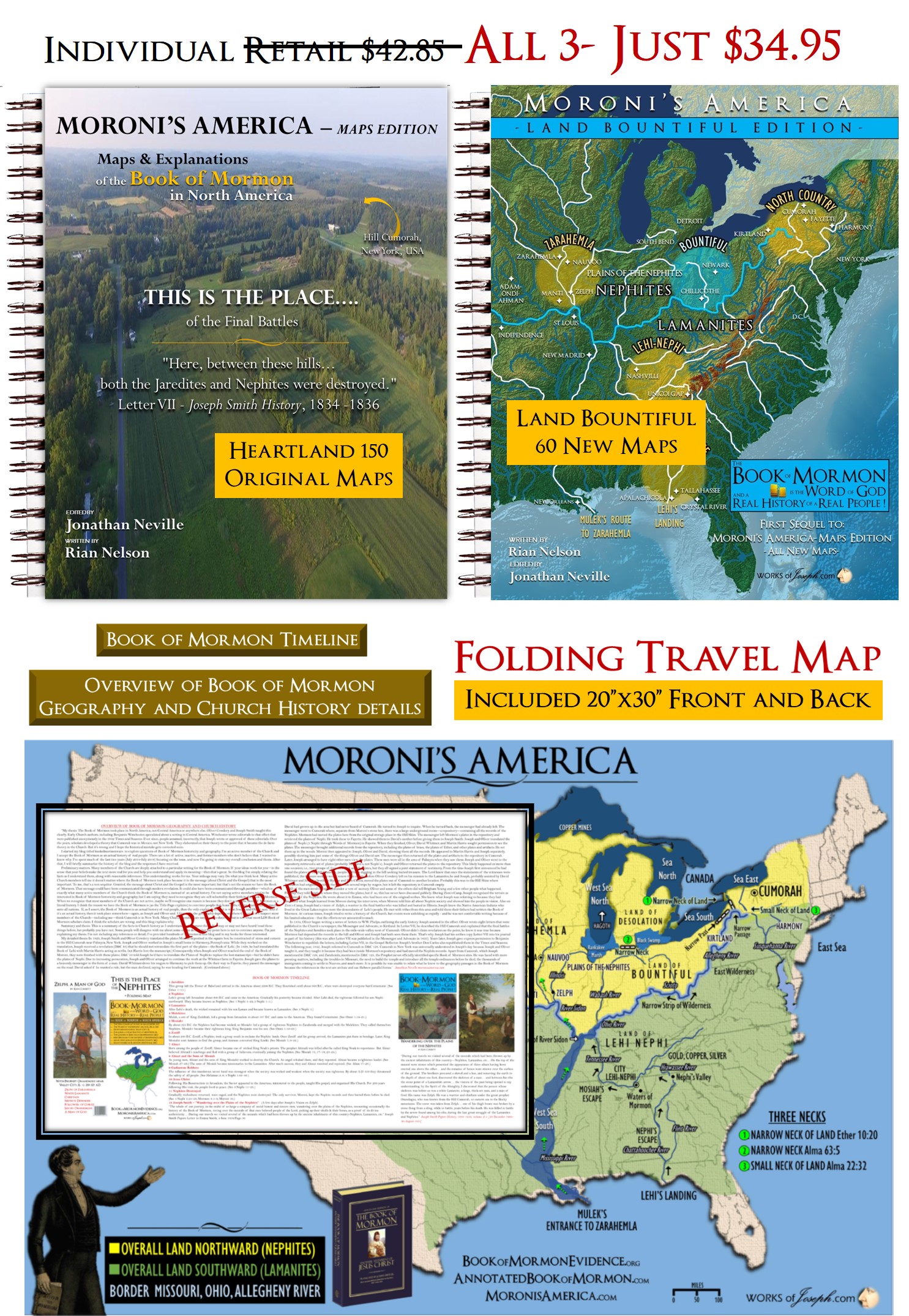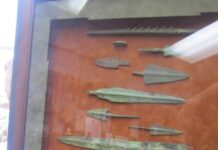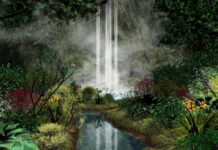My goal each day that I share a blog or information is to share with you what I believe and in know way do I expect you to believe anything without your own research and prayer. I don’t have all the answers, but I always refer to my inner feelings, and I always ask myself the question, “What makes sense to me”? Then I study more and more and then take it to the Lord.
Obviously the Lord cares most about our growth towards immortality with Him, and so many of the questions we ask ourselves are not as important for the Lord to tell us, as it becomes what is most important I would like to know, and how can that knowledge help me and others grow closer to the Lord.?
Where do Dinosaurs come from?
When I was just 12 or so, like many boys I loved dinosaurs. I had them everywhere as toy creatures in the house. I was always killing some other nice dinosaur like the Brontosaurus with my mean and vicious Tyrannosaurs Rex of course. I won every battle! I remember asking my parents over and over about where do the dinosaurs come from, and what happened to them?. I would get the patented parental answer, “I don’t know, or “that’s not important”, or they lived millions of years ago.”
These answers never satisfied me and my parents knew it because they didn’t even know the correct answer either. I was taught by great parents and I was always told to pay about anything and the Lord would answer if you were really wanting it and it was for a good purpose. I took that answer to task for over 14 years. I remeber praying very oftern from age 12 until just after my mission about where dinosaurs came from. I read every LDS author and leader who said anything about dinosaurs, as I was always looking for the answer.
Evolution
Quotes like this from Elder McConkie always helped me. “Evolutionary theories assume that hundreds of millions of years were involved, first in the creation of the earth as a habitable globe, and again in the evolution of spontaneously generated, single celled forms of life into the complex and multitudinous forms of life now found on its face. We have rather specific scriptural indications that the creative period was of relatively short duration.
Bruce R. McConkie, Mormon Doctrine, p. 255
Or Elder McConkie said, “There were no pre Adamites. Any assumption to the contrary runs counter to the whole plan and scheme of the Almighty in creating and peopling this earth.” Bruce R. McConkie, Mormon Doctrine
All things are to be revealed in the millennial day. The sealed part of the Book of Mormon will come forth; the brass plates will be translated; the writings of Adam and Enoch and Noah and Abraham and prophets without number will be revealed. We shall learn a thousand times more about the earthly ministry of the Lord Jesus than we now know. We shall learn great mysteries of the kingdom that were not even known to those of old who walked and talked with the Eternal One. We shall learn the details of the creation and the origin of man and what fools mortals are to follow the fads of the evolving evolutionary nonsense that litters the textbooks of academia. Nothing in or on or over the earth will be withheld from human ken, for eventually man, if he is to be as his Maker, must know all things. (The Millennial Messiah, pp.675-677)
Playing Cards
I was also taught by my parents to not play with face cards and to not drink Coke. My parents knew things like what Elder Joseph Fielding Smith said, “Nothing good comes out of card games or games of chance. There are numerous ways in which we may obtain wholesome amusement and recreation which is beneficial to both body and mind. In games where cards are used usually” stakes” are played for, and betting is done. Someone will obtain the “stakes,” but no one really wins, for the one who obtains the “stakes” has lost part of his manhood which is difficult to regain… Card playing and all other games of chance should be avoided as the gate of destruction. All such practices have been discountenanced by the Authorities of the Church from the beginning of our history.” Vol one Chapter 47 Smith, Joseph Fielding (1957–1966). Answers to Gospel Questions
Isn’t it up to me to decide these answers for myself? Yes, just as you have your own belief. Today I still do not play with face cards and I don’t drink caffeinated beverages. I also believe dinosaurs were created just before Adam and they died in the great flood. That’s just me and you are free to believe as you wish. No one is better than another, we just have a different set of beliefs.
Now to my purpose today. I strongly believe the Book of Mormon events began in the Heartland of North America and then spread throughout the Americas.
Knowing where the Book of Mormon events began, has nothing to do with where Lamanites live or don’t live today. The Lamanites had to begin somewhere and I am confident it was in Florida and the Heartland. Below I will discuss why others think it was in Mesoamerica which is fine with me. You can believe anything you would like and still love the Book of Mormon with all your heart. I’m just a searching and seeking person and I love additional truth from the Lord, in addition to the doctrinal truth that I know The Church of Jesus Christ of Latter-day Saints is the true Church, and we have a prophet today, President Russell M. Nelson.
JOHN SORENSON- Mesoamerican Theory
Lehi and his party launched their vessel into the Indian Ocean from the south coast of the Arabian peninsula. The winds no doubt bore them on the same sea lanes that Arab, Chinese and Portuguese ships used later, touching India and ultimately the Malayan peninsula. From that point Nephi’s ship likely threaded through the islands of the western Pacific, then across the open reaches north of the equator to landfall around 14 degrees north latitude. Nephi left us no information in the Book of Mormon about the route, nor did he tell us in modern terms where they landed. But when we analyze Book of Mormon statements about geography and events, the “land of first inheritance” can only lie west (Pacific) coast of Central America (1 Nephi 18:23; Alma 22:28)… [T]he southernmost portion of Guatemala’s Pacific coast or adjacent El Salvador is most likely where Lehi’s party landed and first settled.(7) Sorenson, John L., An Ancient American Setting for the Book of Mormon. Salt Lake City, Utah; Deseret Book Company and Foundation for Ancient Research and Mormon Studies, 1985, pp. 138-139. http://www.bmaf.org/node/415

ROD MELDRUM- Heartland Theory
“The Book of Mormon explains that Lehi’s sailing party left a coastline they named “Bountiful” in the Old World. Nephi’s descriptions lead us to believe they left the Arabian peninsula, probably in modern-day Oman or Yemen. They crossed the “many waters” and landed at the promised land: “And it came to pass that I, Nephi, did guide the ship, that we sailed again towards the promised land. And it came to pass that after we had sailed for the space of many days we did arrive at the promised land; and we went forth upon the land, and did pitch our tents; and we did call it ‘The Promised Land.’” (1 Nephi 18: 22-23)
This description is so vague that it leaves readers with many possibilities for the landing site. We know from Moroni’s statements to Joseph Smith that the Book of Mormon is a record of the ancient inhabitants of “this country” meaning the United States, and of “this continent,” meaning the American continent, but that says nothing about where Lehi’s group originally landed.
Nephi does tell us the approximate season of the year when they left the Old World, and knowing when they left tells us something about which direction they would have sailed. He states: “After we had prepared all things, much fruits and meat from the wilderness, and honey in abundance, and provisions according to that which the Lord had commanded us, we did go down into the ship, with all our loading and our seeds, and whatsoever thing we had brought with us, every one according to his age; wherefore, we did all go down into the ship, with our wives and our children.” (1 Nephi 18:6).
In the Oman area (see map above from p. 30 of the Annotated BofM), there are two honey harvests each year, (spring and fall) but most fruit is harvested in the fall. That they gathered much fruit just prior to leaving suggests a fall departure. Nephi’s account continues, “…we did put forth into the sea and were driven before the wind…” (1 Nephi 18:8), which suggests that the ship was not traveling contrary to, but in concert with the Northeast monsoon winds that prevail at this season of the year and would have driven the ship southwest, along the eastern coast of Africa (see Ann. BofM. map on p. 35). This route would have rounded the cape into the Atlantic Ocean and followed the currents and winds across the Atlantic to the Caribbean. Once there, the route picks up the currents that Columbus utilized when he left Spain and sailed to the Canary Islands off the western coast of Africa having the ship proceeding westward. In this connection, it is significant that Nephi “looked and beheld a man among the Gentiles, who was separated from the seed of my brethren by the many waters; and I beheld the Spirit of God, that it came down and wrought upon the man; and he went forth upon the many waters, even unto the seed of my brethren, who were in the promised land.” (1 Nephi 13:12). This man has long been considered to be Columbus (see Ann. BofM p. 22). If that’s accurate, then Nephi saw Columbus sail the “many waters” to a land that Nephi recognized as the promised land. That suggests Nephi and Columbus followed a similar route. That doesn’t answer the question of where Lehi landed, but it does indicate it was somewhere along the eastern coast of America. It excludes the possibility of Lehi crossing the Pacific to the western coast of the Americas.
There are two additional reasons for reaching this conclusion. One is a passage in Isaiah 18:1, which reads, “Woe to the land shadowing with wings, which is beyond the rivers of Ethiopia.” The Good News Translation renders the passage this way: “Beyond the rivers of Ethiopia there is a land where the sound of wings is heard.” In the American Standard Version, it is “Ah, the land of the rustling of wings, which is beyond the rivers of Ethiopia.”
The chapter heading in the LDS version of the Bible explains chapter 18 this way: “The Lord will raise the gospel ensign, send messengers to His scattered people and gather them to Mount Zion.” The “land shadowing with wings” has been identified as the Americas. It is significant that Isaiah describes it as a land beyond the rivers (or waters) of Ethiopia, also called Cush, the land south of Egypt. Nephi and Lehi knew the writings of Isaiah, so they would know that the promised land was beyond the waters of Africa. It’s possible they chose to leave during the fall not only so they could gather fruit, but also because they knew the winds would take them around Africa.
A third reason to accept an Atlantic crossing is the actual voyage of the ship Phoenicia, which was a recreation of an actual ship from 600 B.C. (see p. 35 Annotated BofM). The crew intended to circumnavigate Africa, but wind and sea currents pushed them within 350 miles of Florida before they managed to return the ship to the Mediterranean. This experience demonstrates the feasibility of an ancient Atlantic crossing.
Once they arrived in the promised land, Nephi explains that the seeds they brought from the land of Jerusalem grew “exceedingly,” that they eventually found beasts including the cow, ox, ass, horse, goat and wild goat, and that they found ore of gold, silver and copper (1 Nephi 18:24-5). This suggests a similar climate. Both the panhandle of Florida and the area of Jerusalem are located about 30 degrees north latitude. Florida receives more precipitation, which may explain why the seeds grew “exceedingly.” Annotated Book of Mormon David Hocking and Rod Meldrum Page 530-531
Jonathan Neville Heartland Theory
Mormon could not “write the hundredth part” of the events of his people. For this reason we have the record of the Nephites from Mormon’s abridgement, but we don’t have the written record of those who lived in the periphery or “Hinterland.” See Words of Mormon 1:5, Ether 15:33, Isaiah 18:1
“Isaiah 18:1 tells us that the promised land, where the ensign on the mountains would be lifted up, was “beyond the rivers of Ethiopia,” which means beyond the waters of Africa. Nephi knew he would have to sail around Africa.” Moroni’s America Chapter 10 footnote 79

“FOR DECADES, I BELIEVED THE BOOK OF MORMON TOOK PLACE in Central America (specifically, Mesoamerica). I read books and articles written by LDS scholars, visited sites in Mesoamerica, attended lectures, engaged online and in person—let’s say I studied the issue in depth. I know the evidence and can recite the arguments backwards and forwards. But now I’m convinced everything happened in North America.” Moroni’s America Jonathan Neville page 1
Zarahemla-Montrose Iowa
“For the [North] American setting, Section 125:3 is a key to locating Zarahemla. “Let them build up a city unto my name upon the land opposite the city of Nauvoo, and let the name of Zarahemla be named upon it.” Section 125 was the first mention of the name Zarahemla in connection with the Iowa development. Some commentators have argued that this area of Iowa had been called Zarahemla prior to March 1841, the date Joseph received the revelation, but all such references were added retroactively (and after Joseph died) by historians and compilers by way of explanation. With the Iowa Zarahemla as the axis mundi, the American setting has Lehi landing in the Florida panhandle, the Land of Nephi in the mountains of Tennessee, Bountiful in Indiana and Ohio, Zarahemla in Iowa, the Sidon River comprising the river system that includes the Missouri and Ohio Rivers plus the Upper Mississippi, with the West Sea South being the lower Mississippi, the West Sea North being Lake Michigan, the narrow neck being the Niagara Peninsula, and Cumorah in New York, outside of Palmyra—where Joseph Smith found the plates. Essentially, this is the United States from 1838 to 1842, including states and territories.” Moroni’s America page 327 (Emphasis added) Detailed Blog Here
Defining Hinterlands
“Hinterlands is defined here as meaning the unknown area of North and South America that are not within the scope of the writings of the Book of Mormon. In other words, since we believe main events of the Book of Mormon happened in a limited area of North America around the Great Lakes in the east, and Ohio, Indiana, Iowa and Missouri to the west, and south in Tennessee, West Virginia, Georgia, and Florida, all other areas will be discussed as “The Hinterlands”. We propose that Mesoamerica is the Hinterlands along with many other areas of the continent. As Mormon has said, “…I shall take from the plates of Nephi; and I cannot write the hundredth part of the things of my people (Words of Mormon 1:5). There are many people in South and Central America that are Lamanites and part of the Hinterlands.” Jonathan Neville
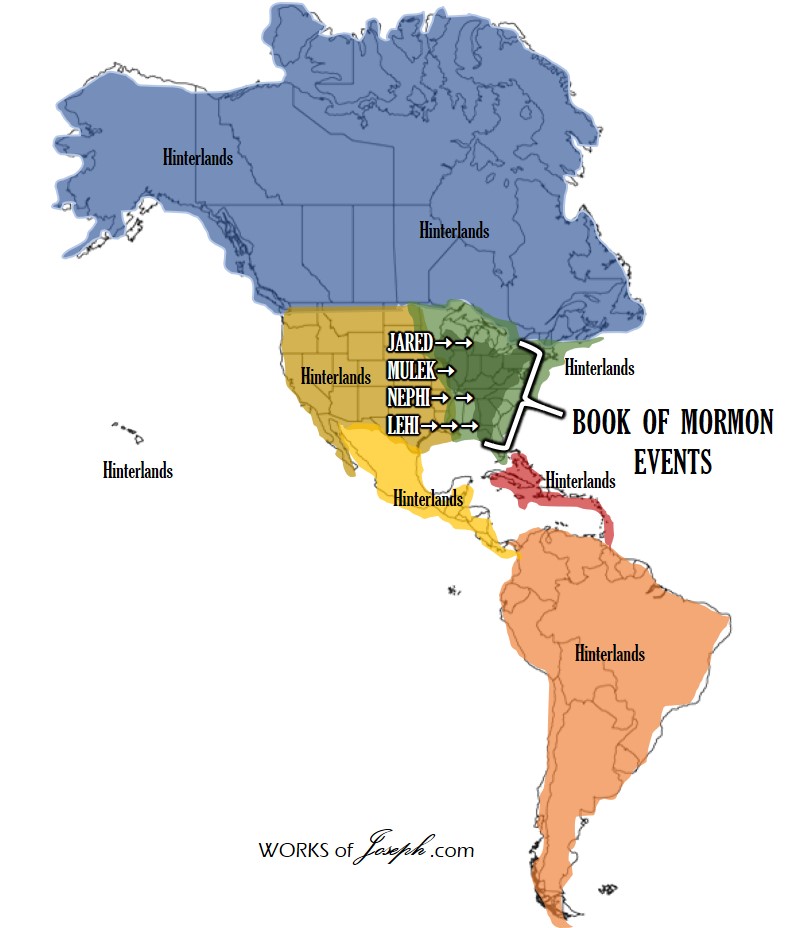
In other words, if the Book of Mormon events took place in Mesoamerica, then every other area would be the “Hinterlands” where other Lamanites may have migrated and lived. If however the events of the Book of Mormon took place in the Heartland of the United States (As we believe they did), then every other area outside of this limited Heartland area would contain migrating Lamanites, including the western United States, Canada, Mexico, and South and Central America. Heartland Core – Where the main Nephite and Lamanite events occured! Mesoamerican Periphery – Where Nephites and Lamanites migrated to outside of this core! (See map above)
Times and Seasons
“FOR DECADES, LDS SCHOLARS HAVE LABORED TO ESTABLISH and defend a Mesoamerican setting for the Book of Mormon because they believed they were vindicating what Joseph Smith wrote (or approved) in three articles published in the Times and Seasons on 15 September and 1 October 1842. The discovery that it was someone other than Joseph Smith, Wilford Woodruff, or John Taylor who wrote the articles, led to the further discovery that Benjamin Winchester wrote the articles linking the Book of Mormon to Central America, and that William Smith edited and published them. These discoveries raise serious questions about the original premise for both hemispheric and Mesoamerican theories of Book of Mormon geography. Although now discredited, these Times and Seasons articles have influenced generations of Latter-day Saints—members, scholars, and leaders —and have been frequently cited by those who advocate a Mesoamerican setting.” Moroni’s America Chapter 28 by Jonathan Neville
“In about 900 AD the Mayan civilization collapsed. Archaeologists and scientists explain that the Mayans most likely went north, probably using the Gulf of Mexico and landed in the southern states of the U.S. It then would have been easy for the Mayans to utilize the rivers to travel inland to the midwest or southeastern parts of the U.S.. We know that one of the largest ancient civilizations of North America is at Cahokia near St. Louis, Missouri. Cahokia is dated at about 1000-1200 AD. Cahokia is not a city that was built by the Heartland Core Nephites, but probably by the Mesoamerican Periphery Mayans.
“Who built the mounds during the Mississippian Culture period? In an interview with a Native American, Wayne May, author and publisher of Ancient American Magazine, asked a Chieftain: “Who built Cahokia?” The Chieftain responded to Wayne: “We did, the Native Americans. But we built it as slaves.” Wayne then asked: “Slaves to who?” The Chieftain replied: “We were slaves to the Snake people who had come up from the south…as a cohesive army. They enslaved us and for the space of 200-300 years they forced us to build these gigantic structures. But then we were finally able to overthrow them and drive them back out of our lands. But by that time we had intermarried with them for 200-300 years. So many of our people ended going back to the southern lands.” The “Snake people” from the south appear to be people that came from Mesoamerica during a time of severe drought in their lands.” Annotated Book of Mormon by David Hocking and Rod Meldrum page 540 (Emphasis added)

Collapse of Classic Maya
“The Classic Period of Mesoamerican chronology is generally defined as the period from 250 to 900, the last century of which is referred to as the Terminal Classic.[1] The classic Maya collapse is one of the greatest unsolved mysteries in archaeology. Urban centers of the southern lowlands, among them Palenque, Copán, Tikal, Calakmul, went into decline during the 8th and 9th centuries and were abandoned shortly thereafter. Archaeologically, this decline is indicated by the cessation of monumental inscriptions and the reduction of large-scale architectural construction at the primary urban centers of the classic period.”- Wikipedia/Mesoamerican chronology Teotihuacan around 600-800 AD
Lamanites Used as Slaves
North America Core – Mesoamerican Periphery
“That the Algonquian, Iroquoian and Siouan immigrants were mound builders is readily proven. It may well be doubted whether the mounds were built by the voluntary effort of a free people. Monuments of such magnitude in all ages and in various parts of the world almost without exception representing the handiwork of peoples who labored unwillingly and under compulsion. It would therefore seem evident that either the invading immigrants must have conquered people of a more primitive type whom they found already in possession of the country and reduced them to a state of servitude, or else that they came as imperial colonists, divided into two classes, namely, soldiers and serfs” – Thoburn, J.B., Prehistoric Migrations, Proceedings of the Oklahoma Academy of Science, Vol. 6 [2014], 372-378. As quoted in Annotated Book of Mormon page 541.
“The question of where the Book of Mormon took place is of great interest to most latter-day saints. Yet confusion has reigned, with over 150 proposed geographies ranging in scale from the entire western hemisphere to that of a small country. Over the past several years the Heartland theory has challenged the Mesoamerica theories as the most widely accepted.
While the Heartland geography model has demonstrated its ability to resolve almost every Book of Mormon textual, prophetic and scientific question regarding its authenticity, questions resulting from temple dedicatory prayers and prophetic utterances regarding Lamanite connections with the peoples of Central America continue to hold some to the Mesoamerican ideas – despite overwhelming evidence in support of the Heartland geography.
Good Faith Attempt
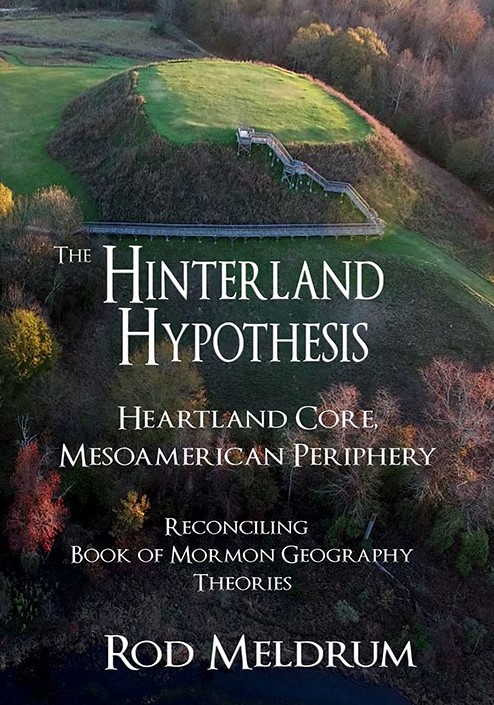
“Mesoamerica archaeologist Mark Alan Wright made a good-faith attempt to reconcile the two dominant theories in an article wherein he proposed a synthesis between the two models by having the main, or core population of the Nephites centered in Mesoamerica, with some small Nephite migrations resulted in forming a periphery people in the north. Thus, acknowledging Joseph Smith’s revelatory statements, such as Zelph, his letter to Emma and the altar at Adam-ondi-Ahman, that Nephites were in America’s Heartland.
Building on Brother Wright’s reconciliatory efforts, it became clear that a synthesis of both models could be attained simply by flipping his idea. Instead of the core Nephite lands being in Mesoamerica with a peripheral population migrating into North America, what if it was found that it was reversed? Suddenly everything works!” Rod Meldrum Details in The Hinterland Hypothesis DVD here.
“During Zion’s Camp while in Illinois, and Missouri, the prophet Joseph Smith said, “ …Wandering over the plains of the Nephites, recounting occasionally the history of the Book of Mormon, roving over the mounds of that once beloved people of the Lord, picking up their skulls & their bones, as a proof of its divine authenticity…” This cannot mean that while Joseph was picking up the bones of Nephites in Illinois that he was referring to divine authenticity of a Mesoamerica record.” Jonathan Neville
Anthropologist Alice Kehoe, Ph.D., emphasizes that, “from… stale and false notions of ancient Native American history, much has been missed in the archaeological record of the Americas that is only now coming to light.” She argues “that the Mississippian, often called “Mound-Building” Culture, had close trade and communication links with civilizations of Mesoamerica (Mayas, Aztecs, their predecessors and contemporaries) and that this link is readily apparent from the archaeological record.” She also argues “that Trans-Gulf contact between the Mississippi Valley and Mesoamerica was quite likely…leading to clear similarities in the culture, religion, and art of the SECC, Midwest and Mesoamerica.” (Kehoe, Alice, “Wind Jewels and Paddling Gods: The Mississippian Southeast in the Post-Classic Mesoamerican World,” Gulf Coast Archaeology, The Southeastern United States and Mexico, Ed. Nancy Marie White, Gainesville, University of Florida [2005], 260-280.)

Squarely in North America
“Back to Wright’s “hinterlands” approach, the ninety-nine percent of Nephite (and Jaredite) history not accounted for in the text could encompass Mesoamerica. One plausible theory is that the Jaredites who were not killed off in “this north country” (Ether 1:1), meaning the New York area in the American model, expanded into the rest of the hemisphere, including Mesoamerica. The text also mentions Nephites escaping “into the south countries” (Mormon 6:15). Any similarities between the text and various cultural, linguistic, mythological, anthropological and other attributes of Mesoamerica can be accounted for through this application of the hinterlands approach. This explains why Mesoamerican advocates can point to correspondences, but not direct ties, between ancient Mesoamerica and the Book of Mormon. This is a promising area of study that will surely produce results in the future. But for Book of Mormon studies per se—the study of the times, places, and people actually described in the text—the best available evidence places the core narrative of the Book of Mormon squarely in [North] America.” Moroni’s America page 352
For more information visit bookofmormonevidence.org
